It has been quite some time since I’ve spent appreciable time with a revolver. That recently changed when Mike asked me to review a couple guns from Rock Island Armory. I planned to review the RIA AL22M in .22 WMR first, followed by the .357 Magnum RIA AL3.1, but it didn’t quite work out that way. I’m sorry to report this is one gun I would strongly recommend against buying; Read on to find out why.
First Impressions
The RIA AL22M is a very beefy, 8-shot, .22 Magnum. I was prepared to be in love with this revolver from the start. First, it’s a .22 Magnum. I don’t have a whole lot of love for the .22 LR, but I’m a fan of the Magnum rimfire cartridge. This would be just the ticket for the rats, fisher, raccoons, possums, and armadillos (yes, somehow we have armadillos here in Appalachia, now) that frequent my yard, seeking entrance to my chicken coop.
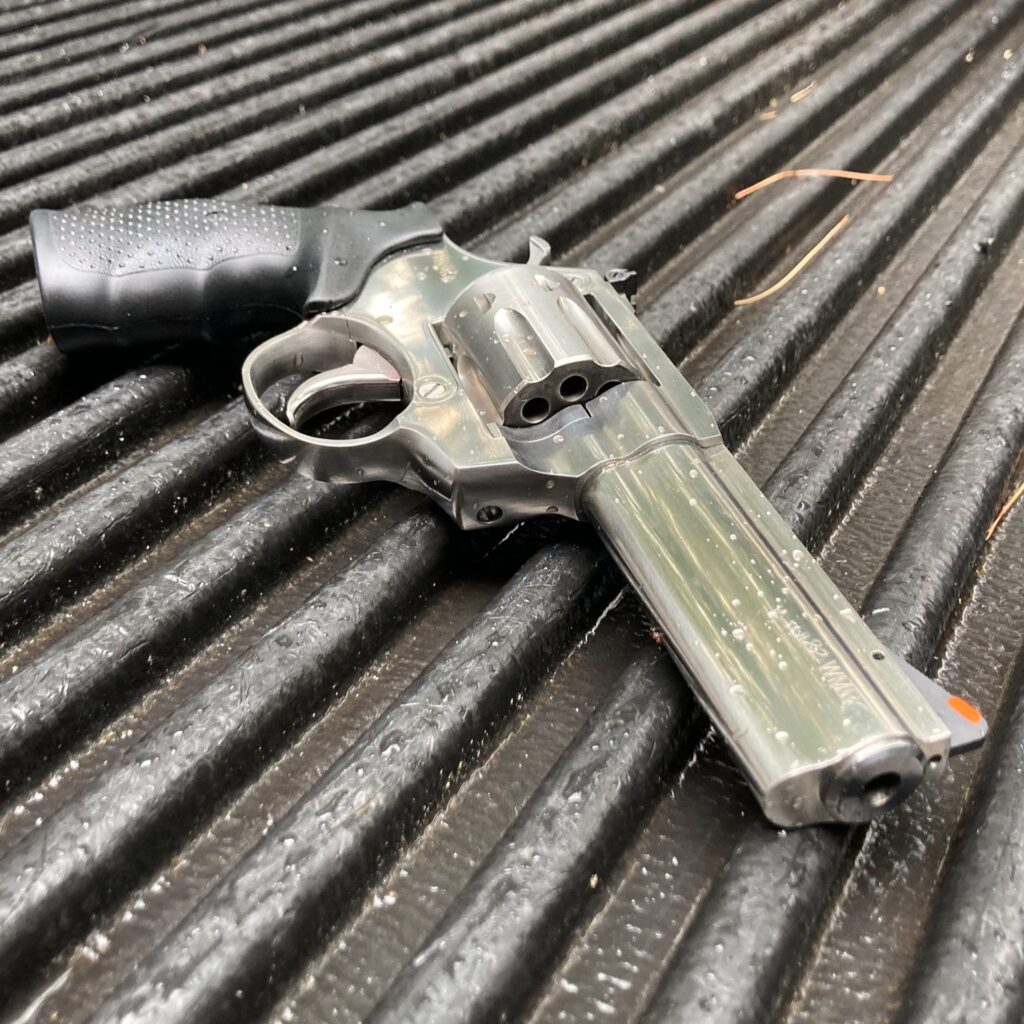
Not only is its chambering desirable, it’s also about the perfect size for an all-purpose, farm/trail/truck revolver. The AL22M is a K-frame-sized revolver. In fact, it can use K-frame holsters (but not grips, unfortunately). With a 4″ barrel, I expected plenty of accuracy, in addition to just being a well-balanced, good-looking wheelgun. I received it alongside RIA’s very snubby, slightly ungainly, AL3.1 .357, which might’ve underscored the rimfire revolver’s good looks just a bit.
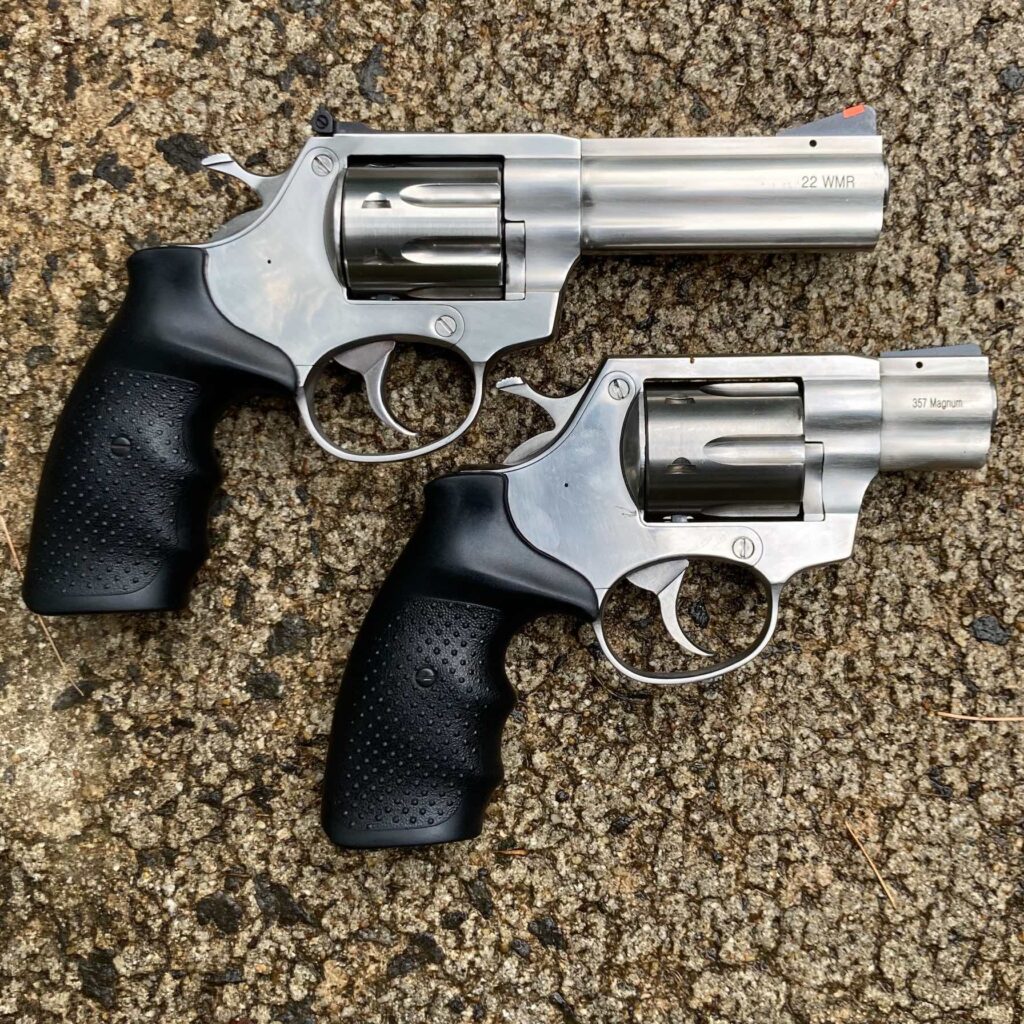
When I started examining the gun up close I wasn’t disappointed. The new crop of revolvers from Alfa-Proj in the Czech Republic appear to be exceptionally well-built, fit, and finished. In fact, there is no comparison with RIA’s budget-friendly, Philippine-produced, M200-series revolvers; These are very nice guns. I didn’t open this gun up, but not a single external part appeared to be cast. Not only that – the AL-series appears to have some very nice features. Let’s take a closer look at the RIA AL22M revolver.
Barrel & Sights
Let’s start at the muzzle. The barrel is very heavy (in fact, this appears to be built from the exact same stock as their centerfire revolvers) and has a full underlug. Not only does this make recoil virtually non-existent, it also lends a very pleasing appearance to the revolver. I wouldn’t mind seeing a recessed muzzle crown, but as we’ll see, this gun has bigger issues to tackle, first. The distal end of the right side of the tube is stamped, “22 WMR”.
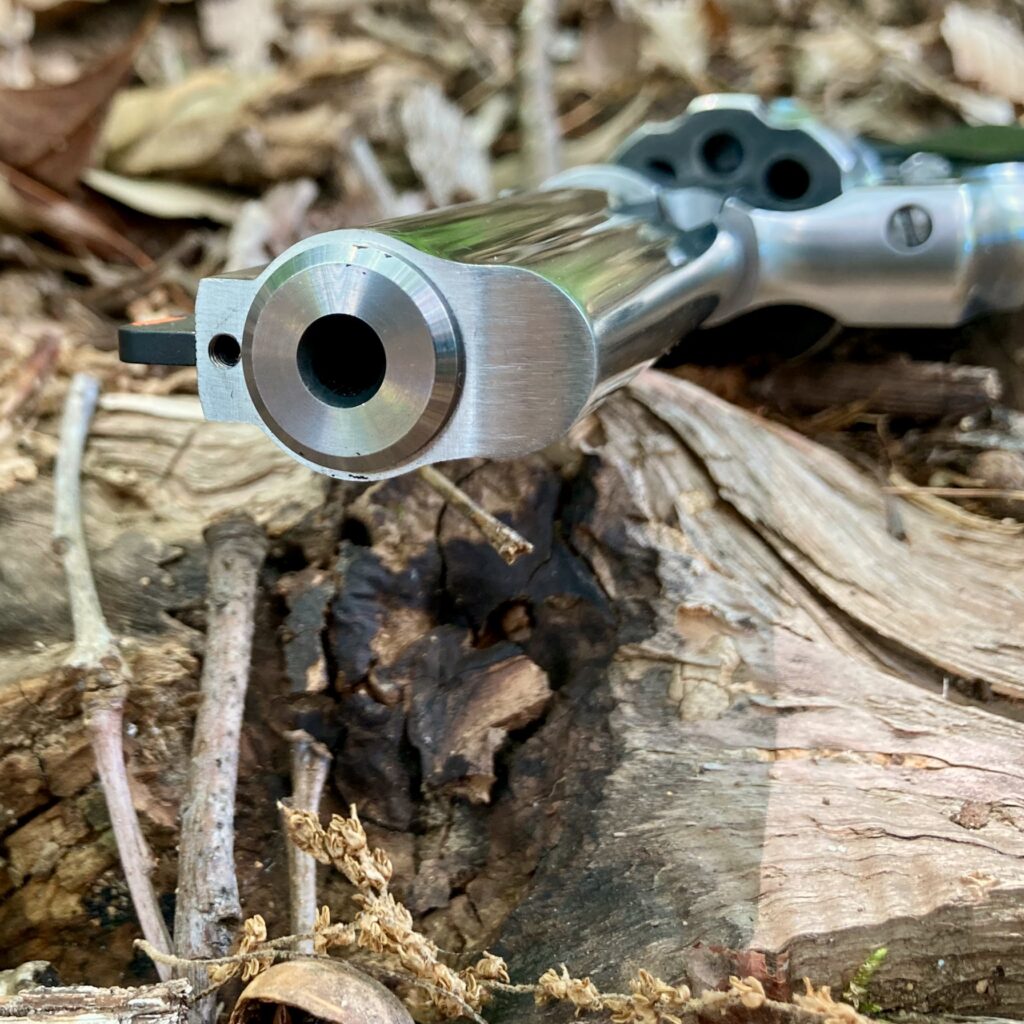
Atop the muzzle is a very nice, serrated front sight with a red insert. The sight is fairly narrow but mates well to the adjustable rear and is well suited to precision aiming. The sight also appears to be removable via a set screw, though I have yet to see replacement blades on the market, and for a revolver like this I don’t think finding one would be a priority for me.
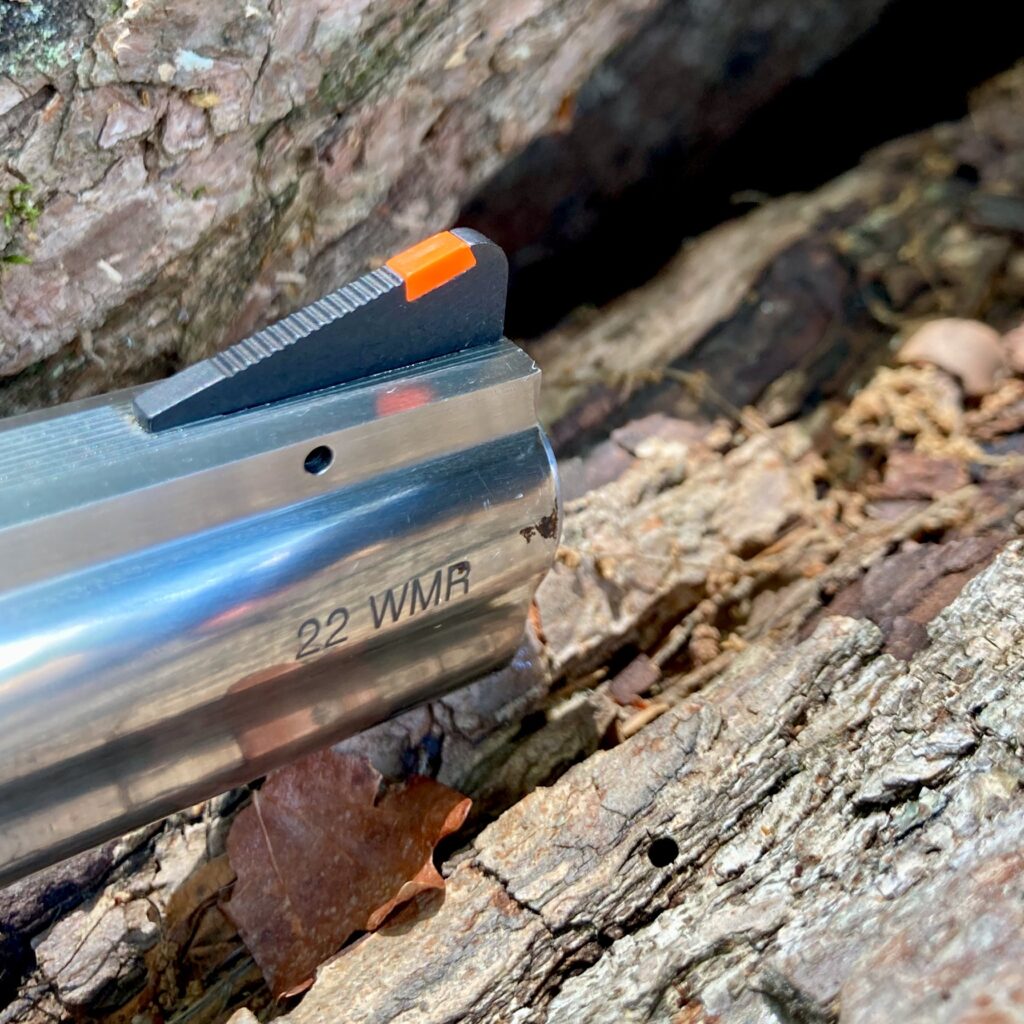
The top of the barrel is serrated, as well, to cut down on glare. I really appreciate features like this. They aren’t necessary, but they demonstrate just a little bit more effort and attention to detail.
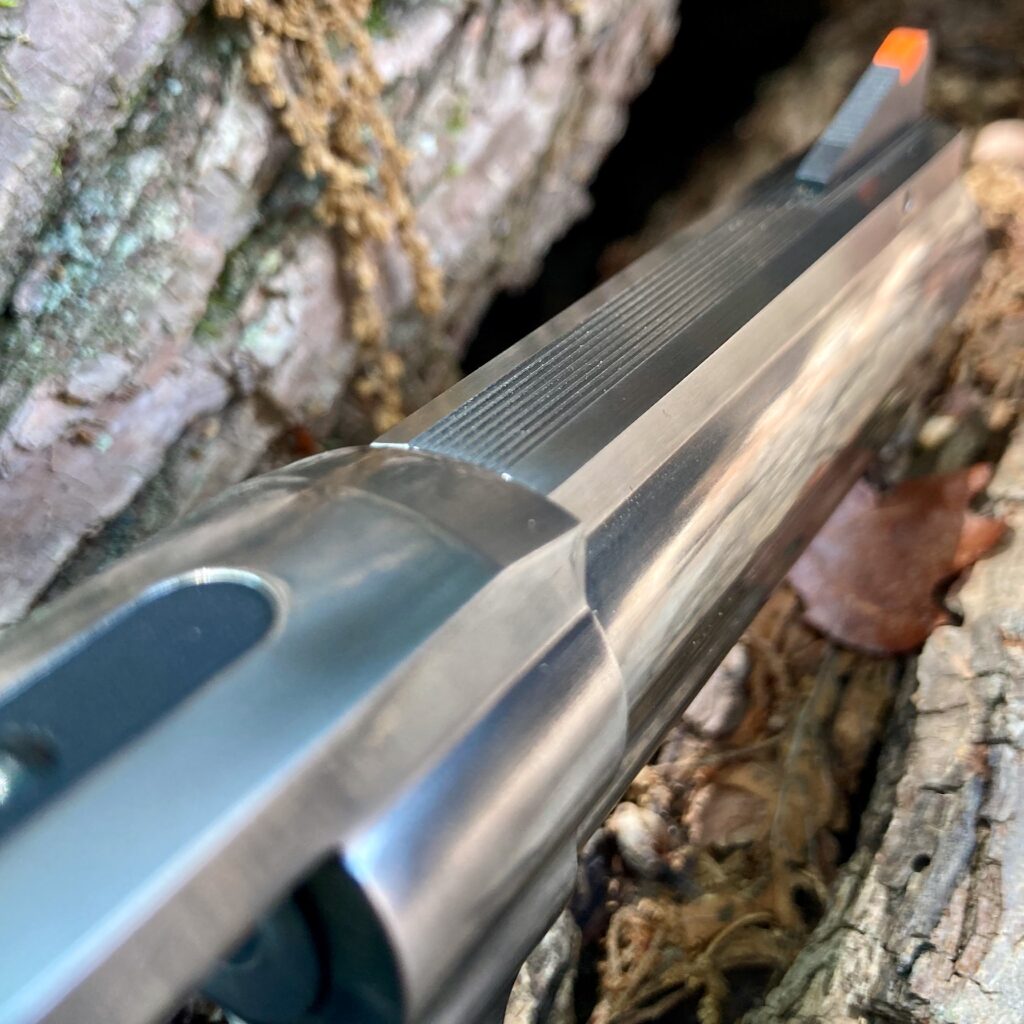
The rear sight is a very nice, adjustable unit that will be familiar to any user of S&W revolvers. The elevation adjustment has very nice, audible and tactile clicks. The windage adjustment on my sample(s) had tactile clicks but they were a bit spongy. The sight blade is outstanding with ideal width and depth relative to the front sight. The barrel and sights should make this gun an outstanding shooter…or so I thought.
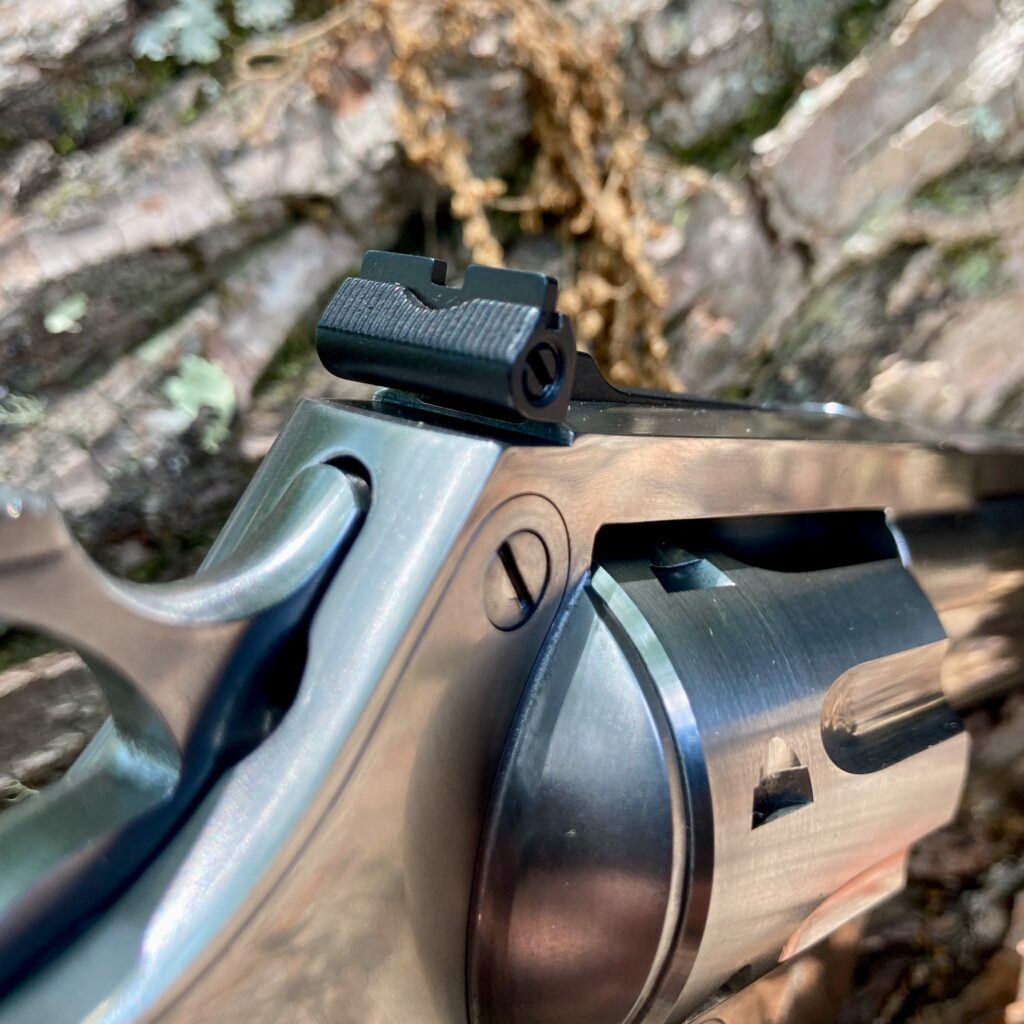
Cylinder Stuff
The fluted cylinder holds 8 rounds of .22 Magnum ammunition. It locks up at the rear, again likely owing to S&W inspiration. One really interesting feature are the relief cuts at the bottom of each chamber. These allow the RIA AL22M to be dry-fired without damaging the firing pin. This is one of those extra-thoughtful features that make me want to love this gun.
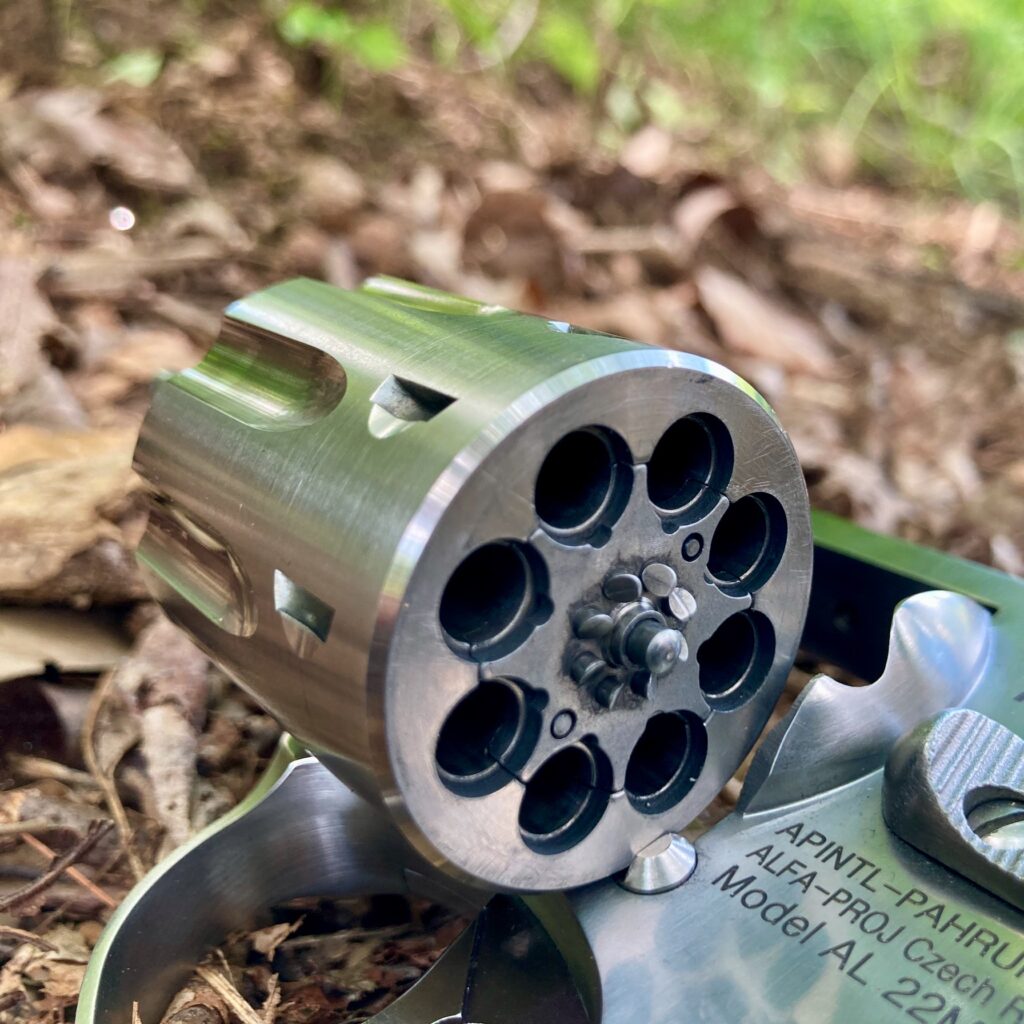
The extractor star is operated by an excellent ejector rod. Ejector rods are done so poorly on many revolvers but this one is truly fantastic! It offers sufficient throw to cleanly eject .22 Magnum brass. Even better, the end is solid and rounded, with a non-“cigar cutter” tip, to borrow a term from Greyson, a frequent reader and occasional contributor. This is really an outstanding ejector rod.
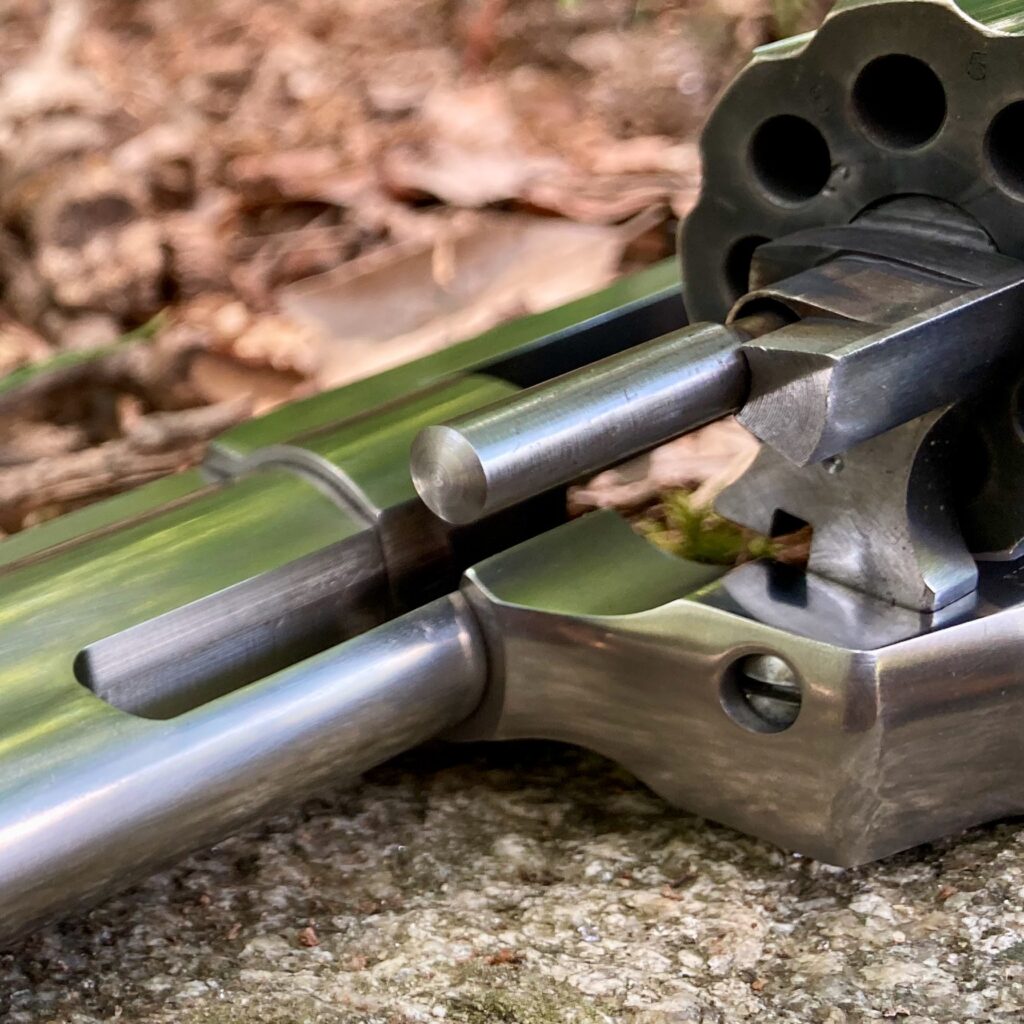
The cylinder release latch is, again, in the S&W style. To actuate it, press it forward. The latch does have a very nice ledge to catch your thumb, and never failed to work for me. Personally I think the looks of the latch could be improved upon. It doesn’t really matter, but the looks of the serrated (rather than checkered) latch don’t quite appeal to me for some reason.
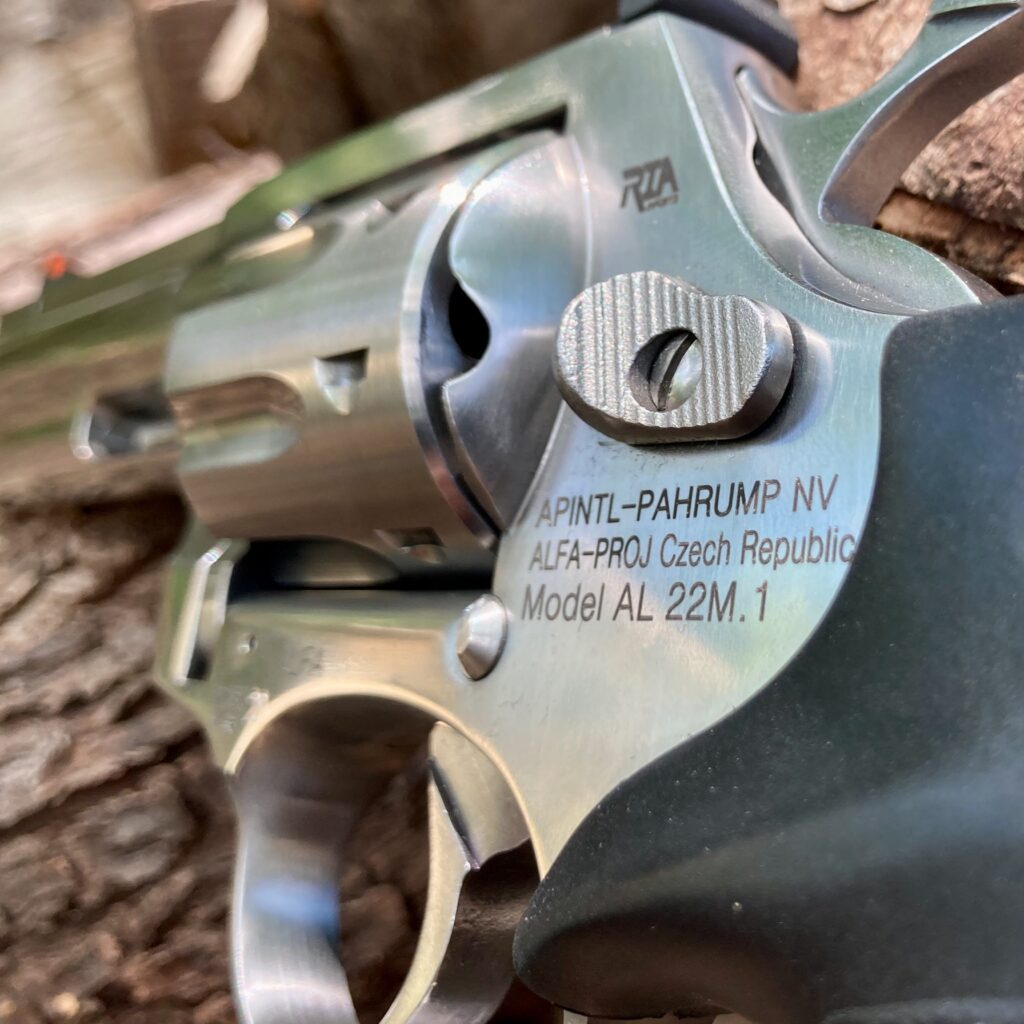
Fortunately there is plenty of text on the side of the gun to distract from the cylinder release latch! Again, aesthetics are a secondary consideration, but this isn’t a $240 budget gun. With the beautiful fit and finish, and an $800 price tag, the text could be toned down just a bit.
Hammer and Trigger
The RIA AL22M functions in both single- and double-action. I generally subscribe to the theory that pure defensive revolvers are (or should be), in practice, DA-only guns. This revolver is much more versatile than a .38 snub, however, and I think the ability to shoot well-aimed, single-action shots is not misplaced.
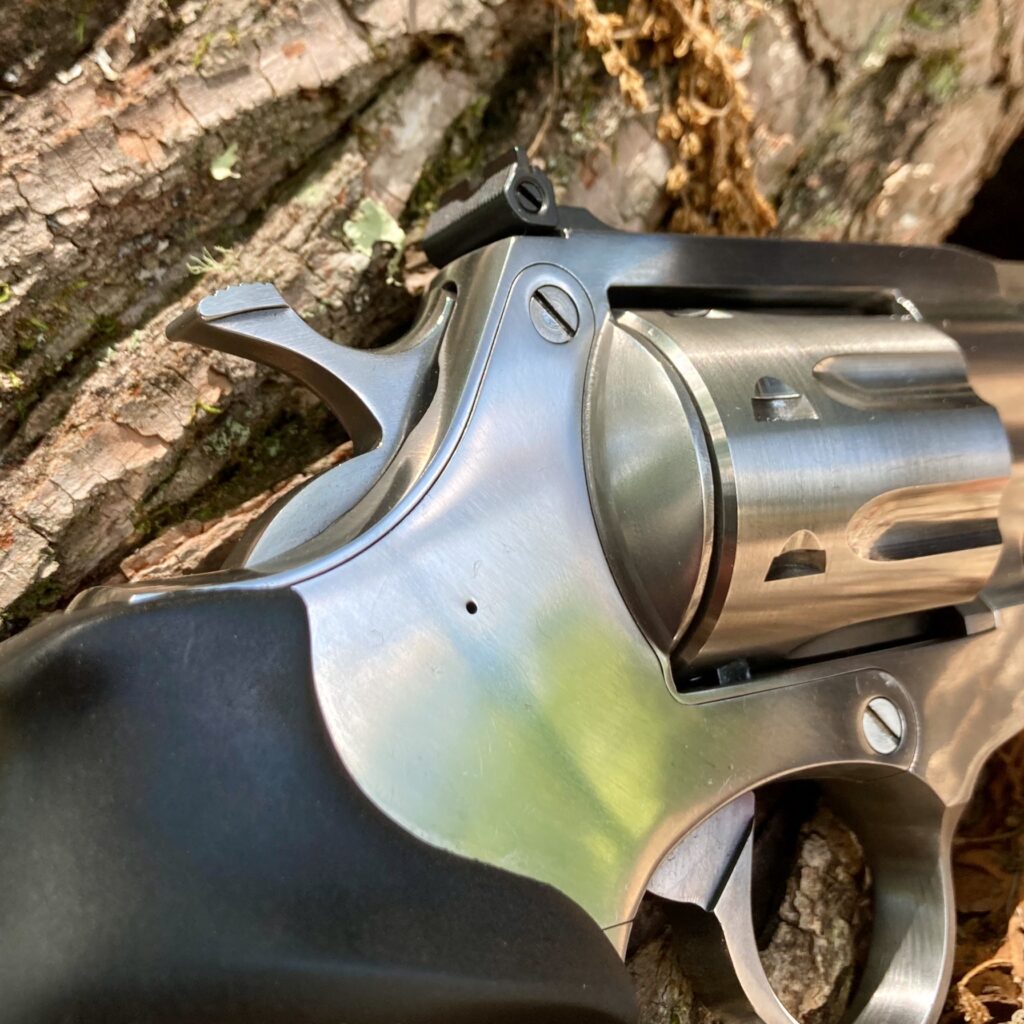
The hammer itself is very functional with a wide, serrated area for thumb-cocking. Under the hammer there is a transfer bar safety, making this gun drop-safe and suitable for carry loaded with all eight chambers loaded.
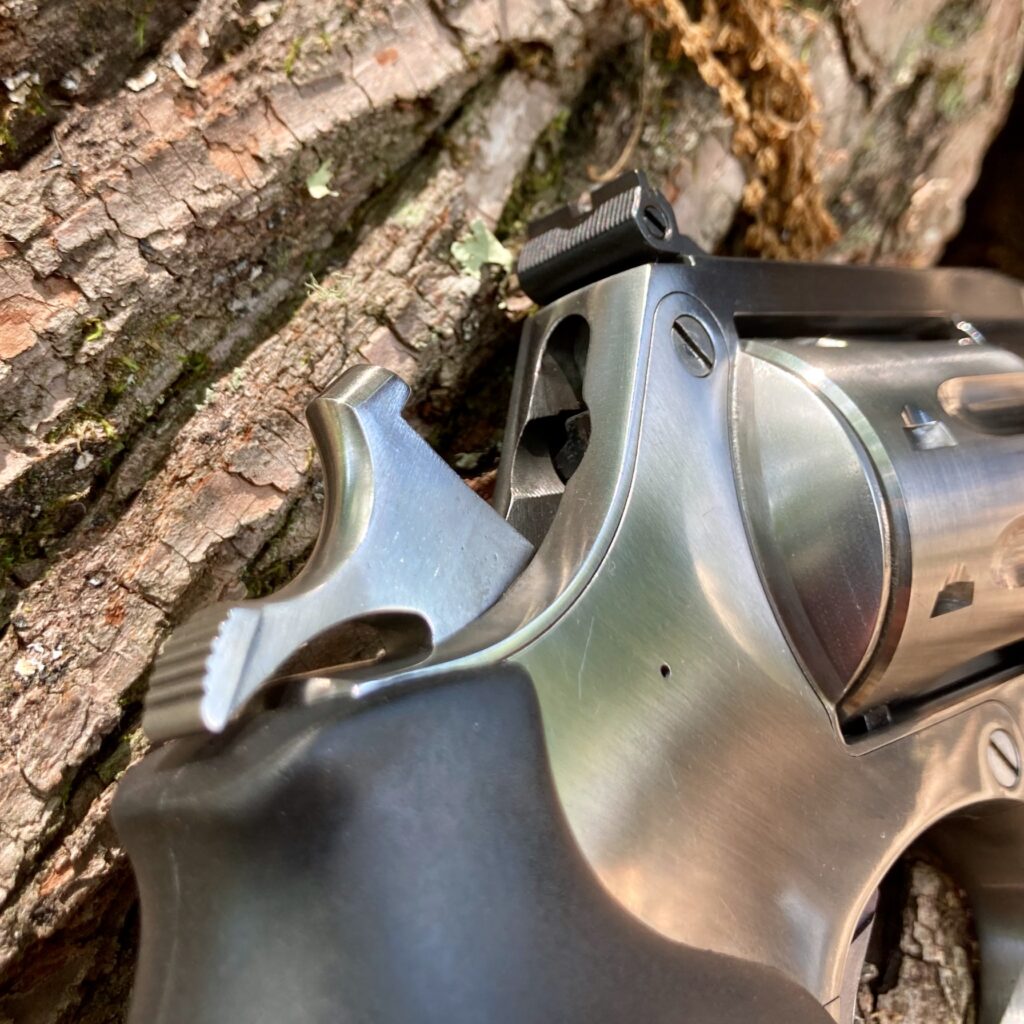
The trigger is about medium-width (see that, Colt?) and serrated. While I would prefer a smooth trigger, the serrations are so fine that I barely noticed them. I found the DA trigger pull to be a bit on the heavy side with an average of 12.9 lbs…then again this is a rimfire revolver. After a couple hundred pulls it was very smooth, which negated the weight somewhat. The SA trigger is one of the best I’ve ever shot. It breaks incredibly cleanly with an average pull weight of 3.125 lbs.
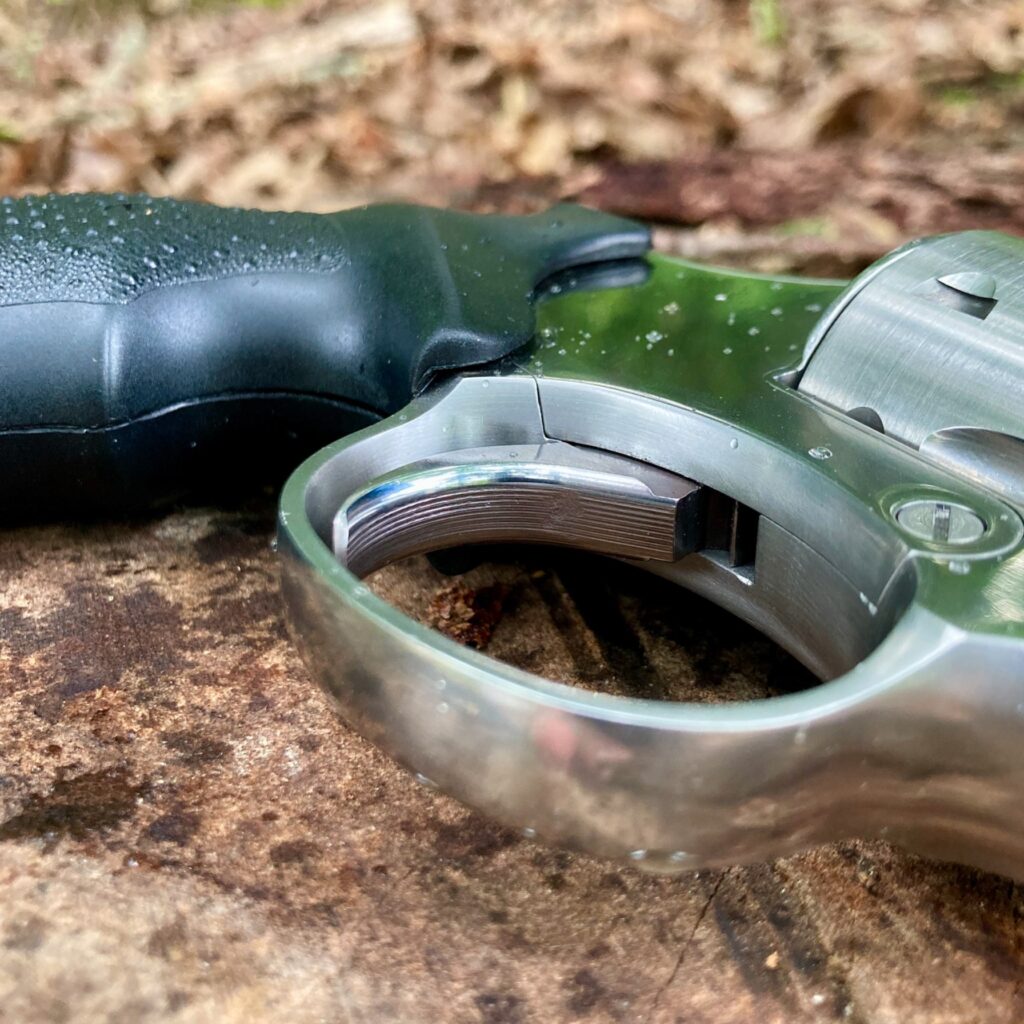
Ergonomics
Let’s start with the grip on this one. Sadly, it can’t be changed…wait, actually it can, but good luck finding replacement stocks. While about the same size as a K-frame grip, the grips attach in a completely different manner. This makes it hard to change for shooters with larger or smaller hands, and grips are one of the few ways you can personalize your revolver.
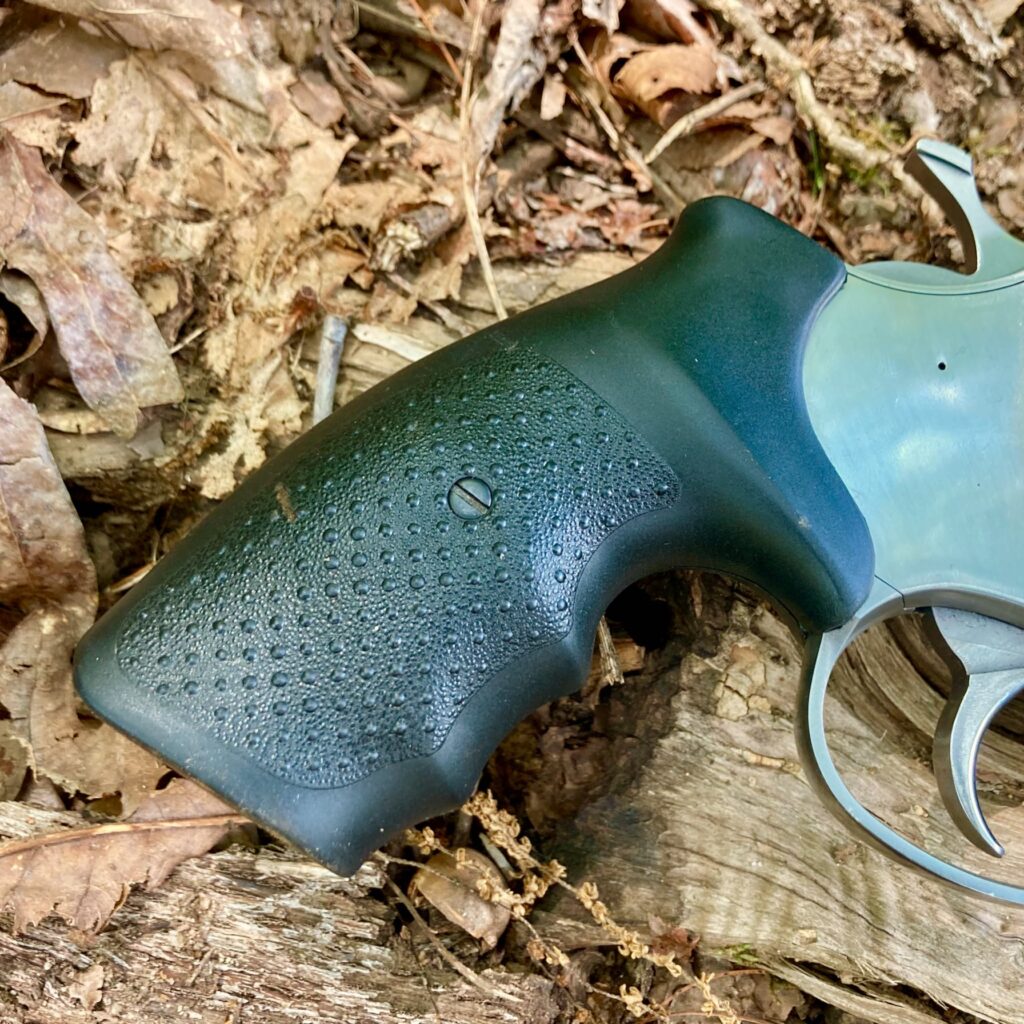
Fortunately, it isn’t a bad grip at all. It’s a Goldilocks size, neither to big not too small for most shooters. It does have finger grooves which I usually don’t like, but didn’t find them to be detrimental in the least here. Though they look like plastic the feel like hard rubber and worked really well. I’m honestly not sure I would swap them, even if I could.
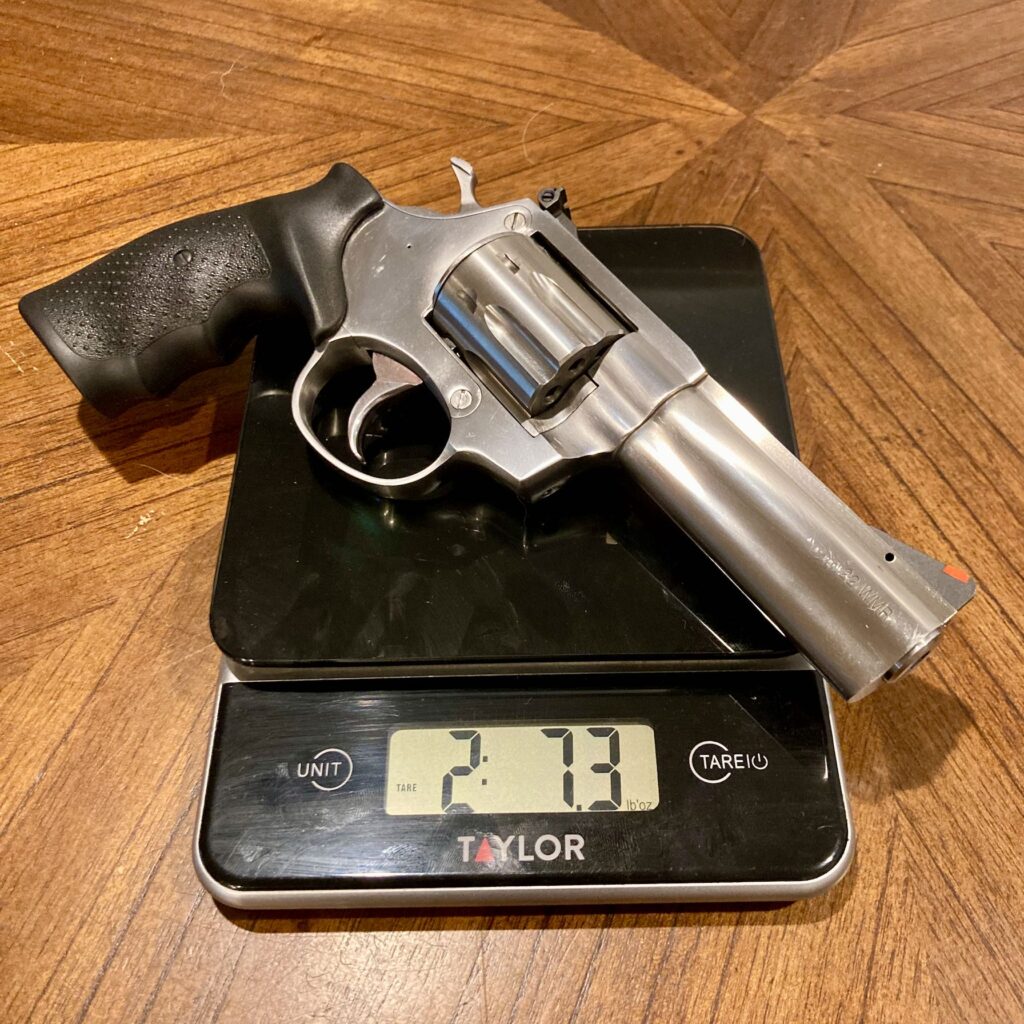
The other ergonomic factor I’d like to discuss is weight. This is not a lightweight revolver. According to my kitchen scale it weights 39.3 ounces. That’s about the same weight as my 4″ 686. Fortunately, it balances exceptionally well. The only place the weight would be a problem is when carrying it for long spells, something I would be inclined to do with the RIA AL22M.
The RIA AL22M at the Range
So far, everything on this gun checks out. It appears to be tank-tough and well-crafted with thoughtful features. It doesn’t appear that Alfa-Proj (the manufacturer; RIA is the importer) took any shortcuts. I was ready to contact RIA and request to buy the AL22M…until I took it to the range.
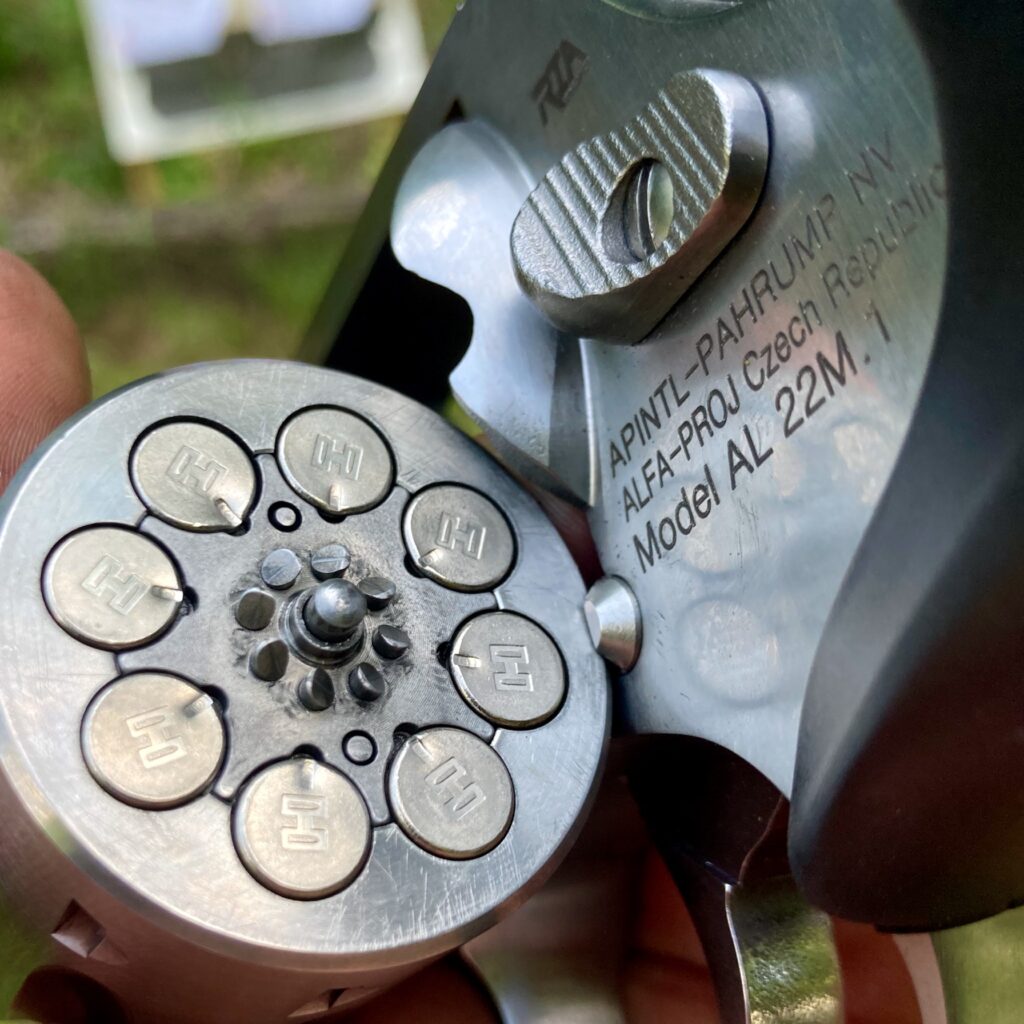
Aside from a S&W 610 on loan to me with a misaligned barrel, I’ve never had a revolver that had inherent accuracy problems that were so bad that that I wouldn’t buy it. Some guns are hard to shoot and some are more accurate than others. This gun had real accuracy problems, though, and unfortunately for me, that’s a deal-breaker.
My first couple of cylinders were fired in my yard. I set up a couple of beer cans and took a few pot shots. When the first couple of shots missed I chalked it up to out-of-the-box sight regulation, or my own lack of recency with revolver triggers. A few days later I made it to the range. I took a bunch of ammo and was really looking forward to seeing what the AL22M was capable of. In total I fired 165 rounds:
-
-
-
- 92 – Armscor 40-grain JHP
- 8 – Hornady Critical Defense 45-gr FTX
- 15 – CCI Maxi-Mag 40-gr JHP
- 24 – Federal 50-grain JHP
- 24 – Win Super-X 40-grain JHP/FMJ
-
-
I shot a bit of several loadings, a cylinder or two at a time. Accuracy wasn’t anything to write home about, but I was keeping everything with about a 4″ circle, so again, maybe it’s just me.
Keyholes
Things were going OK until I loaded up a cylinder of Hornady Critical Defense rounds. Bullets went all over the paper. Vowing to buckle down and do better I loaded up some CCI Mini-Mags. I moved to 10 yards, fired eight rounds in single action, and got the following group:
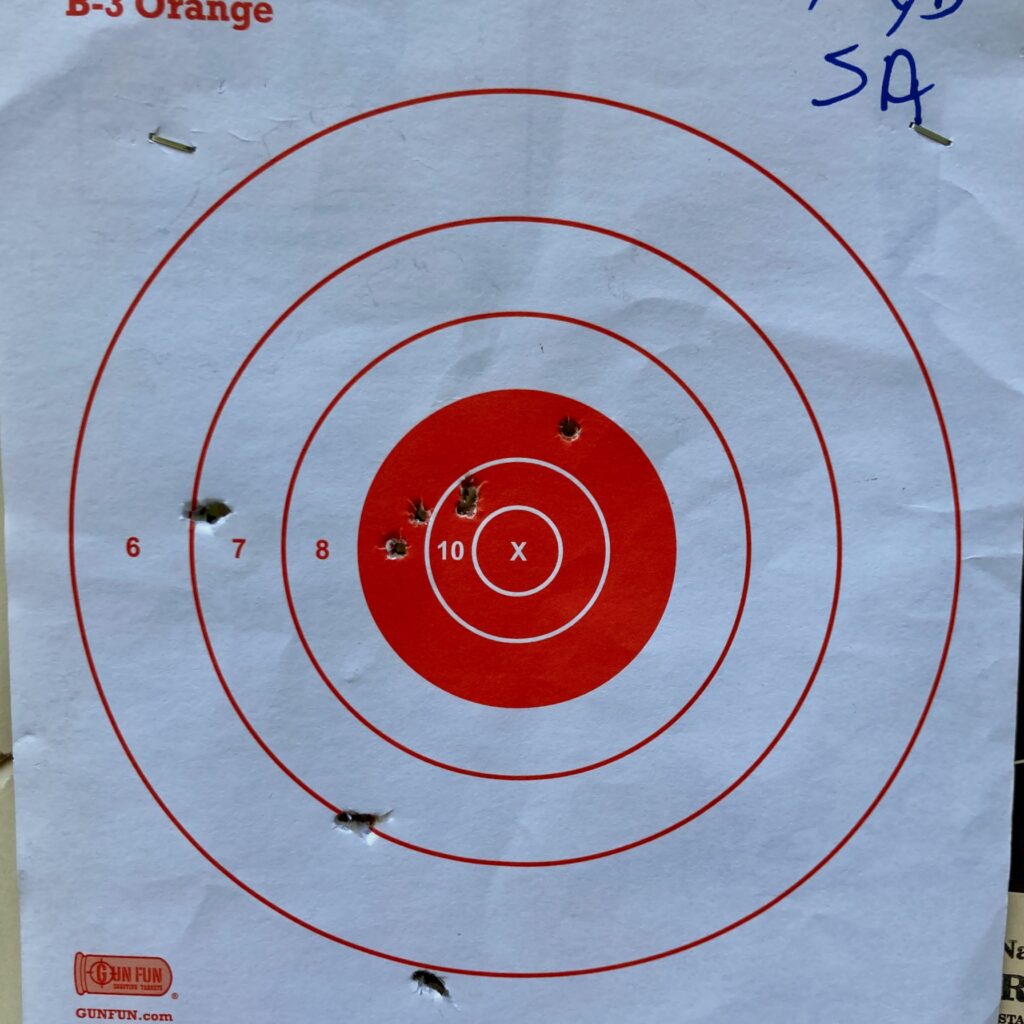
Now I was really confused. Inspection of the target revealed that some bullets were key-holing. Maybe it was the ammo? I shot groups with all the ammo listed above except the Winchester stuff (which I ran out of) and at least one bullet out of every type of ammo turned into a sideways-flyer.
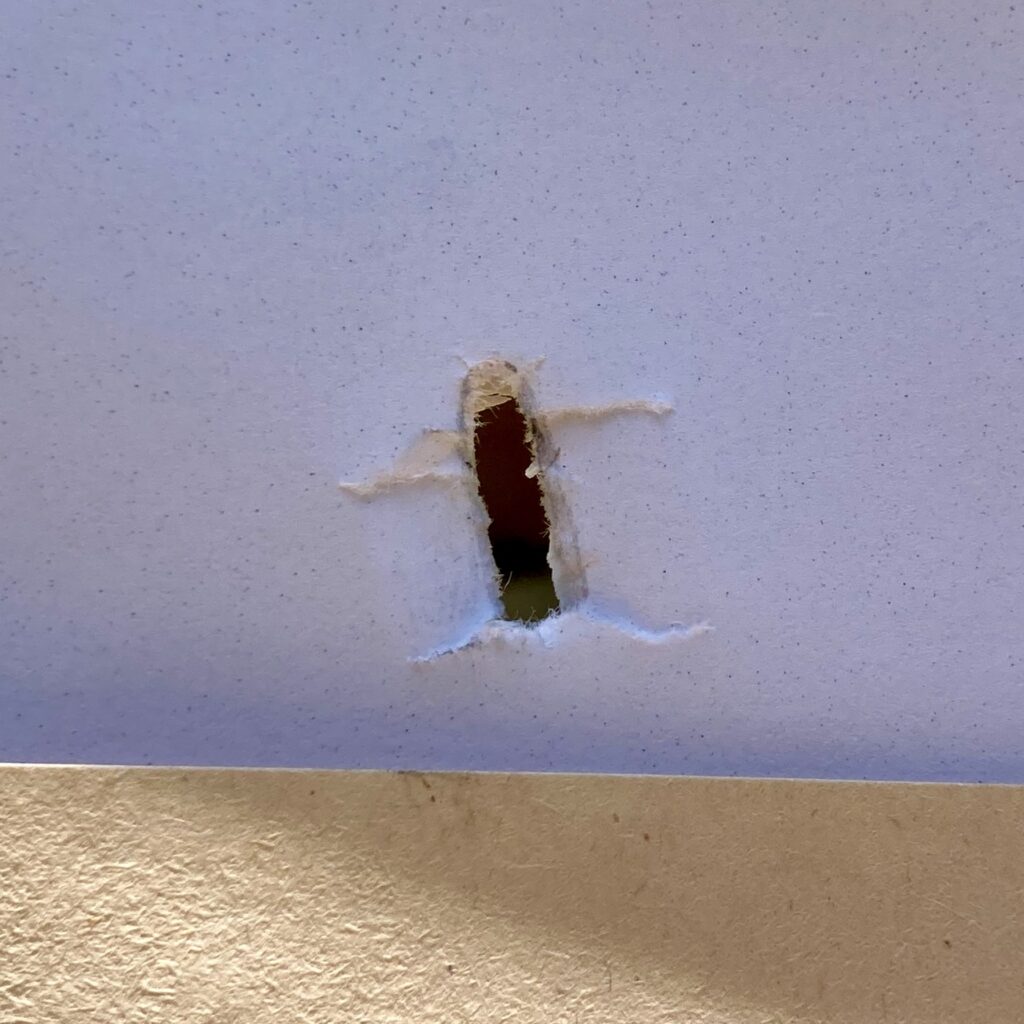
Some ammo did better. The 100-rounds of Armscor ammo that was provided to facilitate this review did the best. Still, even it exhibited an occasional flyer.
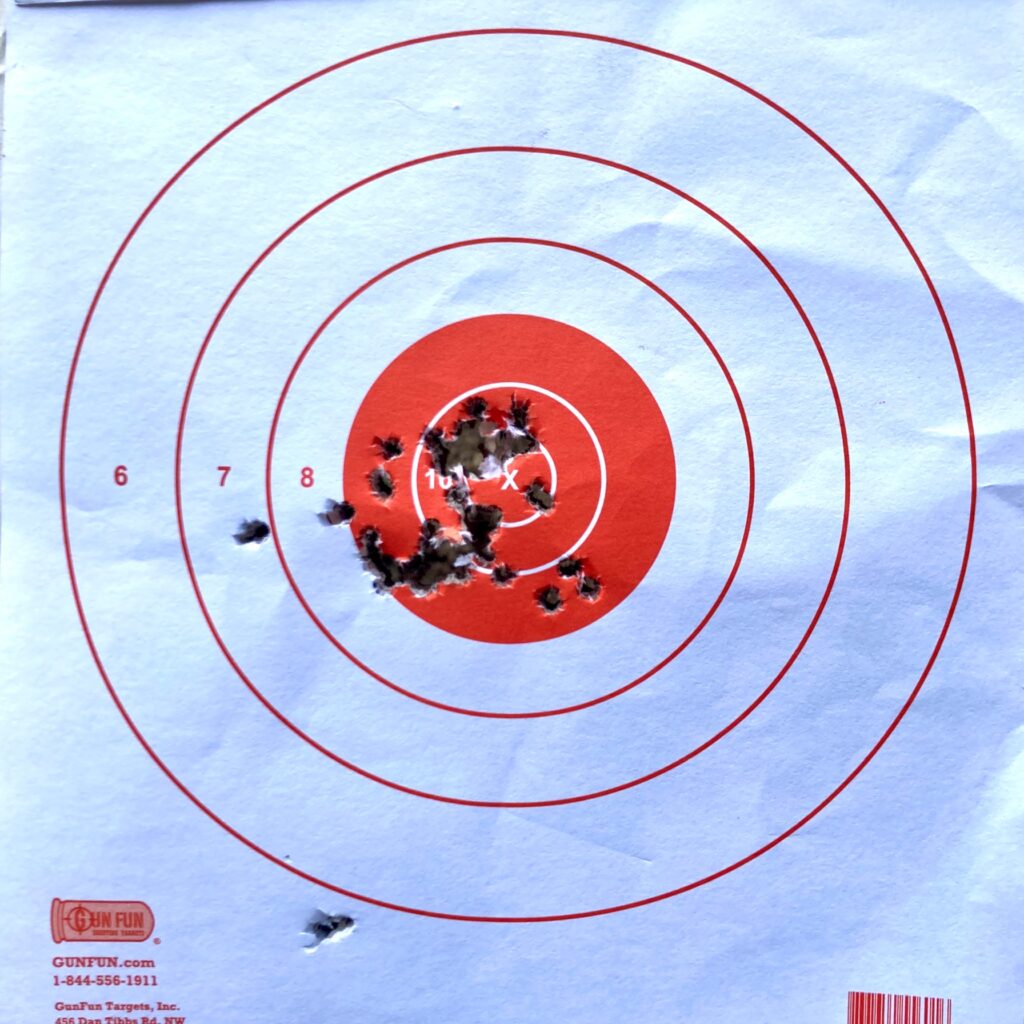
I did a little bit of research and it seems like this isn’t an isolated issue; at least one other Youtuber has had similar accuracy issues. In fairness to Armscor, I requested a replacement revolver for further evaluation, and I’ll address its performance below.
Function and Reliability
The first sample functioned very well throughout my testing (which, oddly, makes me even more sad about the accuracy issue). Out of 165 founds fired, only one didn’t go “bang.” It was a really, really old (like, two decades old) box of Winchester Super-X ammo so I don’t really put that on the gun.
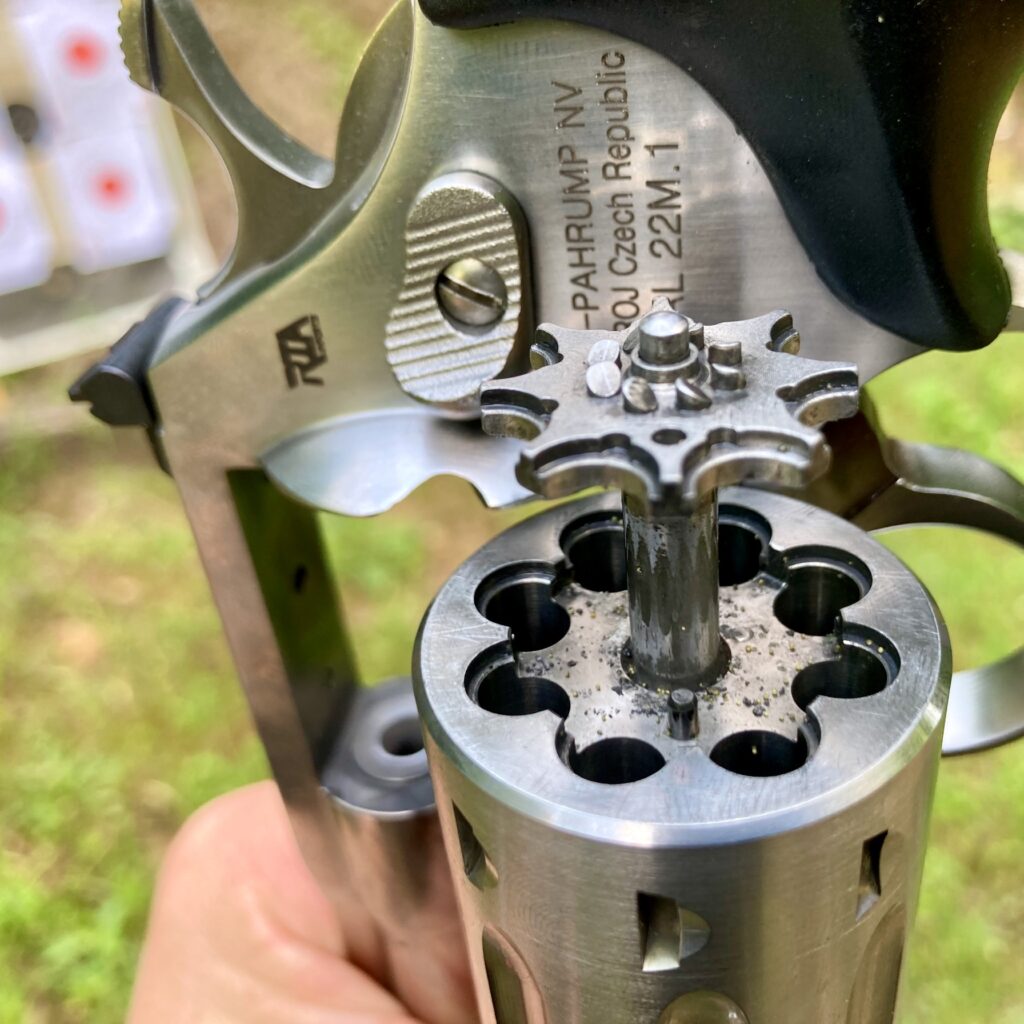
One repeated issue I did have was powder accumulating under the extractor star. Five or six cylinders in the gun started getting really, really tight. I had trouble closing the cylinder so I peeked under the star. Sure enough, there was quite a bit of powder under there. This isn’t unique to the RIA gun and seems to be pretty common with .22 WMR revolvers.
I was prepared for this when I went to the range with my second sample of the RIA AL22M. I showed up with a toothbrush and cleaned under the star after every couple of cylinders. This took hardly any time but made the overall shooting experience much more pleasant.
Due Diligence
Disappointed with the first gun’s performance, I reached out to my media contact about the accuracy issues I was having. They sent a shipping label and I got the gun turned around, with promises that a new one would be on the way. Due to a miscommunication, it took us almost a year to get a second gun. Most of this review was written in May or June of 2022; The second T&E sample came on April 7th of 2023. I picked it up on April 10th and headed straight to the range.
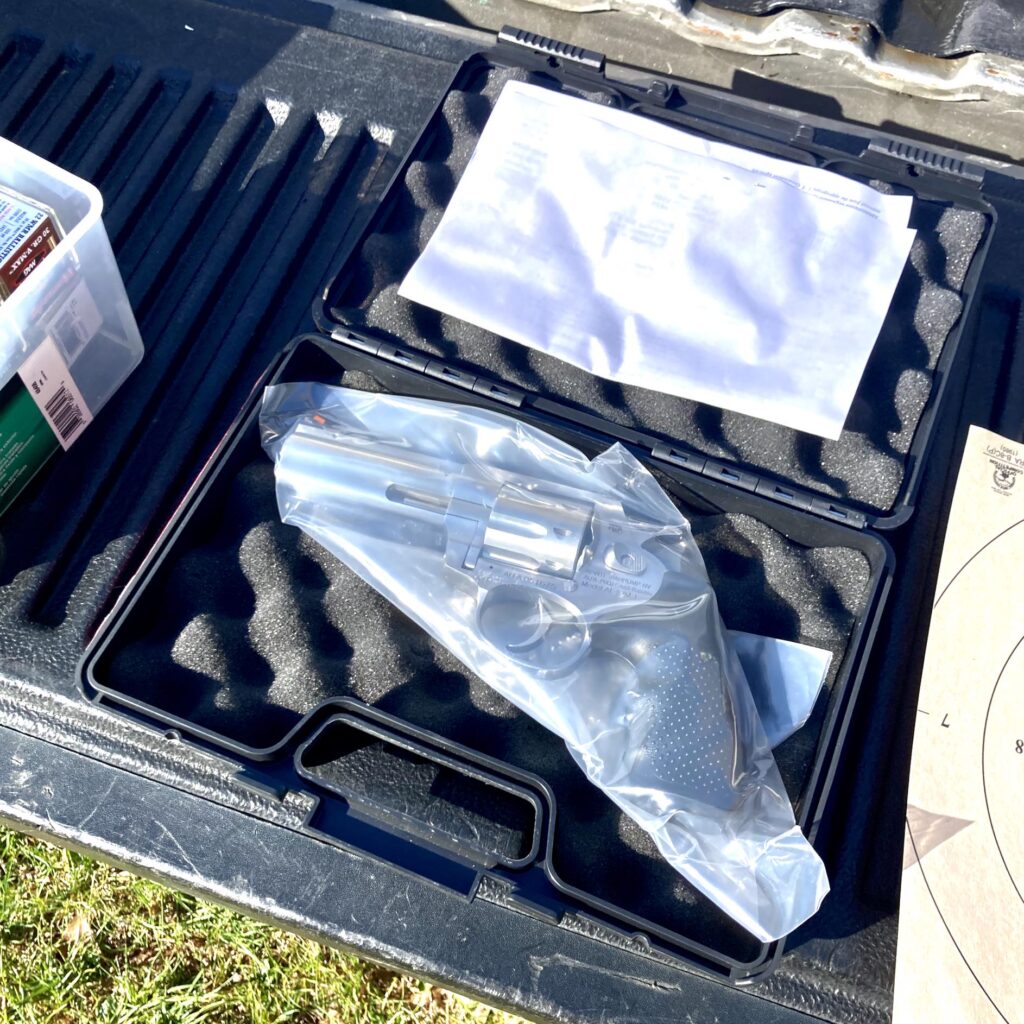
I came prepared. In addition to the toothbrush, I showed up with five boxes of ammo in weights ranging from 30 to 50 grains. I set up a target and got to work. I was confident the last gun had been a fluke and that this one would do the trick. I fired 40 rounds each of the following, for a total of 200 rounds:
-
-
-
- Hornady 30-grain V-Max
- Speer 40-grain Gold Dot
- CCI 40-grain Maxi-Mag FMJ
- Winchester 45-grain Dyna-Point
- Federal 50-grain Small Game
-
-
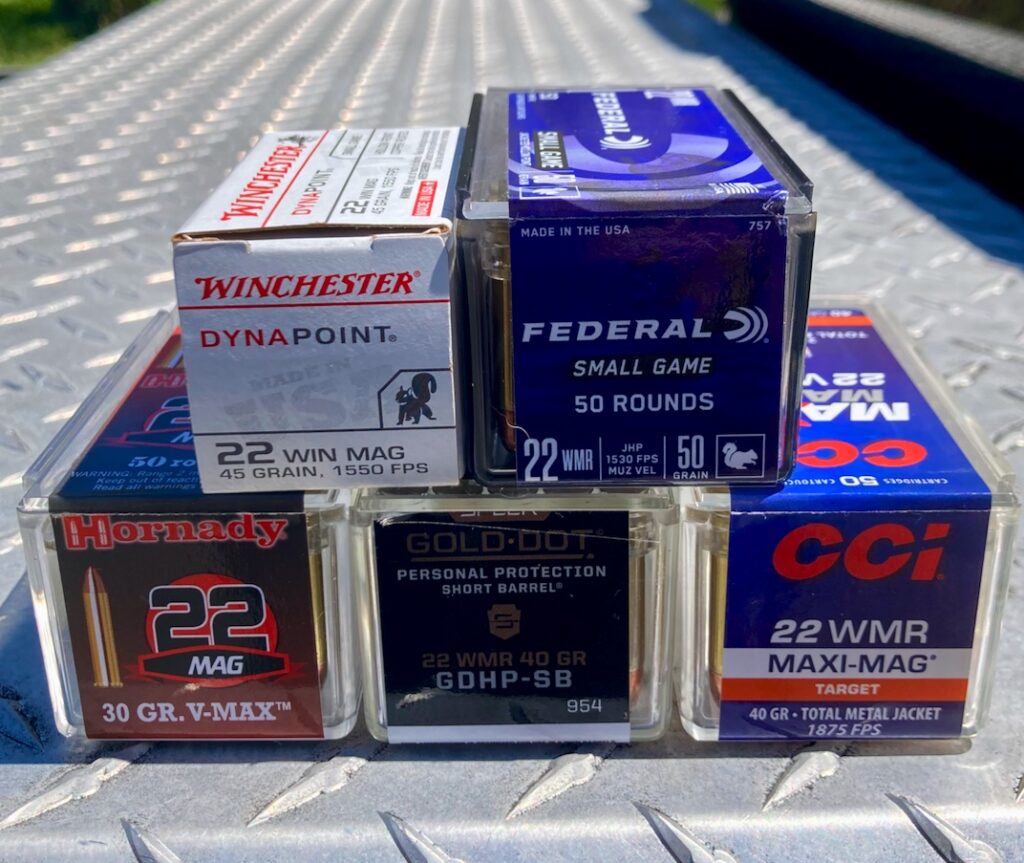
Again, the gun functioned beautifully, and was a pleasure to shoot. This time every single round went “bang” without fail. Unfortunately the accuracy issues rapidly re-emerged. With each of these rounds I experienced key-holed shots.
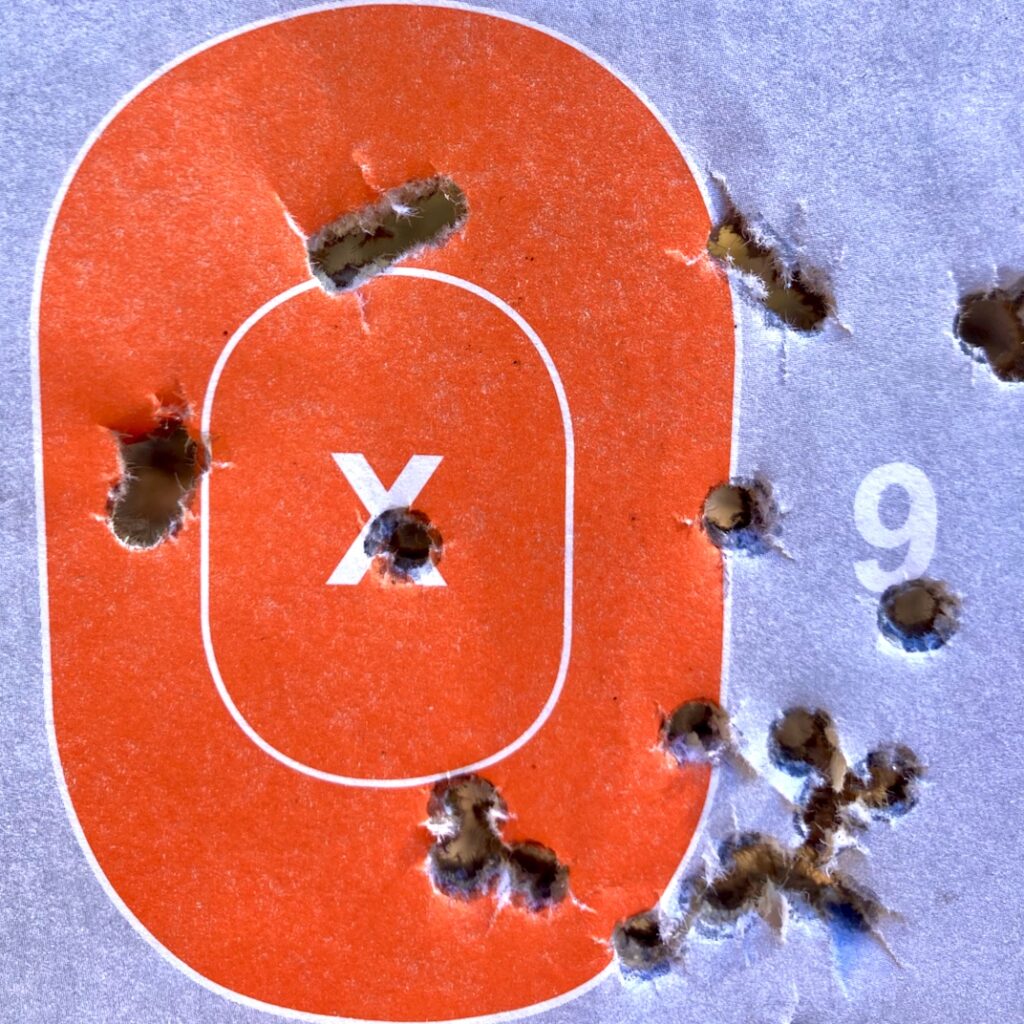
In total, I fired 360-something rounds through two pistols. I fired ammuntion weighing 30, 40, 45, and 50 grains. I fired ammo from CCI/Federal/Speer, Winchester, and Armscor, and I fired all this ammo, roughly 60/40, on two completely different revolvers delivered almost a year apart. I also got the same bad results as another reviewer. This tells me that, while this may not be an issue with all the AL22M revolvers out there, it’s at least common enough that you’re pretty likely to get one. For the MSRP of over $800 that’s not a bet I’d recommend you take.
Closing Thoughts
I had really high hopes for the RIA AL22M revolver. To me this seems like an ideal platform for the potent .22 Magnum cartridge. The mid-sized frame, in durable stainless steel, with a 4″ tube…what’s not to like? With terminal ballistics giving .38 Special a run for its money, an 8-round cylinder, excellent sights, and a good trigger this could be an excellent, do-it-all revolver.
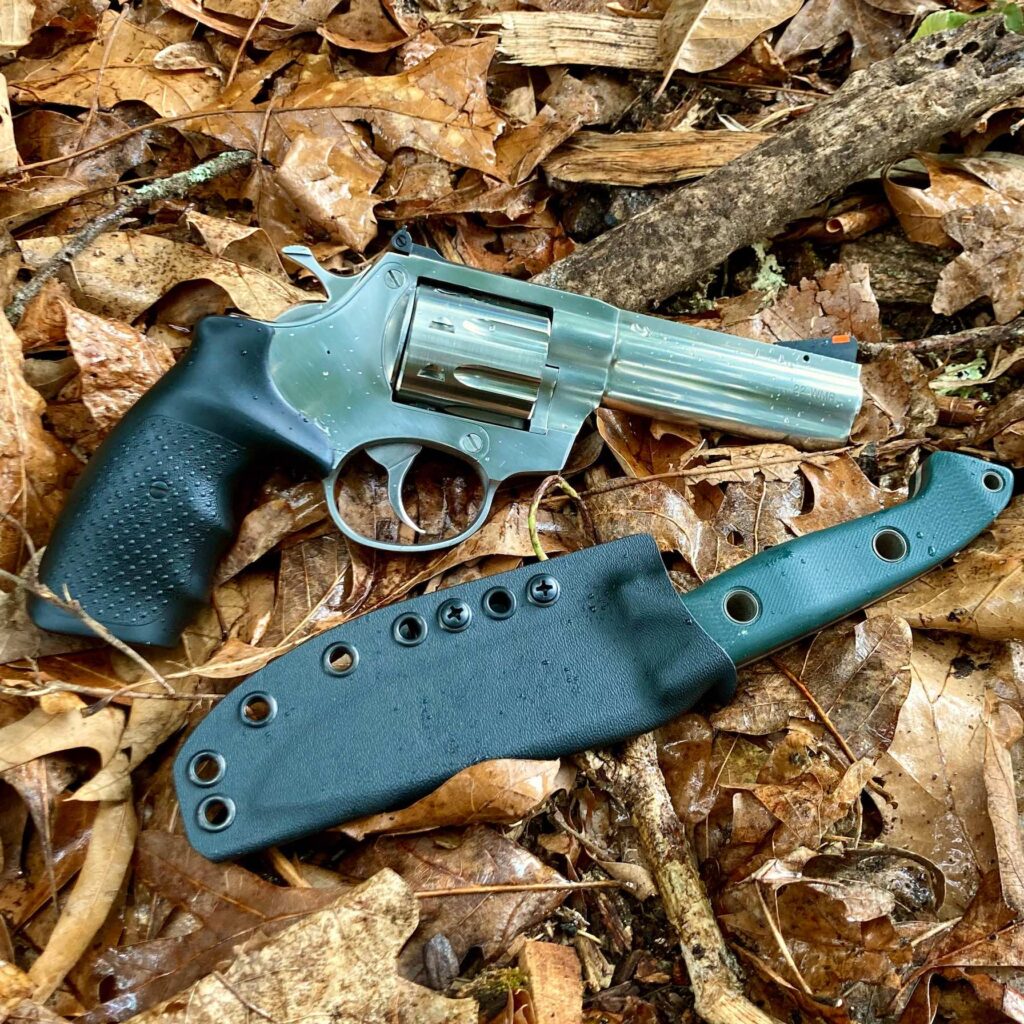
Some of you may know, but I’m on the hunt for my ultimate wilderness survival handgun: a double-action, medium-framed, lightweight, stainless steel, .22 Magnum revolver, with a 4″ barrel, and preferably of the 8-shot persuasion. I’m aware of the 3″ LCRx (too short, and too ugly) and the S&W Model .48 (blued, pricey, and only a six-shooter). Aside from being lightweight, this gun appeared to have everything else and I was prepared to purchase it.
Unfortunately the accuracy issue is a deal-breaker for me at any price. We saw the same issue with two guns delivered almost a year apart. And this is not a cheap gun. At actual street prices north of $800, at the time of this writing, this isn’t some budget revolver – it’s competing with Ruger and S&W. Being unable to shoot accurately wastes ammunition, and creates a potential safety issue if this gun is used in self defense. I sincerely hope that RIA and Alfa-Proj work to correct this (and possibly issue a recall) because the RIA AL22M has so much potential, as we saw with the AL3.1.
A Quick Note on Negative Reviews
I hate to issue a bad review, but I know people spend hard-earned money based on what we say in these pages. This was driven home to me when I attended Greg Ellifritz’ Snubnose Revolvers class a couple years ago. There I met a fellow student named Neil, a fellow who would become a good friend. He showed me the 640 Pro Series that he had purchased on my recommendation.
At that moment I was hit with an incredibly visceral realization that people make decisions to spend money based – at least in part – on our opinions of these guns. That first meeting with Neil is something I’ve never forgotten. As badly as I hate to write a bad review, I feel like this is a good chance to underscore the emphasis we place on being honest with our audience.
*****
Editor’s Note: RevolverGuy readers who have read Justin’s very favorable review of the RIA AL3.1, and Kevin’s very favorable review of the RIA AL9.0, know that we don’t harbor any prejudice towards the brand. I was excited to discover the Alfa-Proj/Armscor AL-Series revolvers at the 2022 SHOT Show, and immediately coordinated to obtain samples for T&E, because I thought they were worth our time and attention. That’s a standard that many new guns don’t meet–we’re selective, and we pass on a lot of opportunities, here at RevolverGuy.
We had high hopes for the AL22M, and Justin obviously appreciated a lot of the features and qualities of this gun, but the continued accuracy problems were impossible to overlook. We’re not sure what’s causing the problem, but we know that RevolverGuy readers deserve to know about it.
Justin said there was no trace of asymmetric copper/lead smearing on the forcing cones of the guns, and he didn’t experience any spitting, so we don’t suspect timing issues or irregularities with the forcing cones. He also reported that the crowns appeared to be square and the rifling at the muzzles appeared to be undamaged. He didn’t slug the barrels, so we don’t know if they’re being drilled and rifled to the proper dimension, but it would take a pretty sloppy bore to overcome the bullet’s ability to obturate and stabilize.
Without examining the guns myself, I’m prone to suspect an issue with the twist rate, or (less likely) the forcing cone geometry, but a good gunsmith should be able to diagnose the problem without much drama. We hope this report will encourage Alfa-Proj and Armscor to investigate the problem and fix it, as our previous reporting on the (then new) Kimber K6s firing pin failures encouraged Kimber to fix that otherwise-excellent gun. As consumers ourselves, we’d like to see an improved version of the AL22M that shoots as good as it looks. We’ve already asked Armsor to send us a new sample to test, when they figure out the problem and fix it.
-Mike

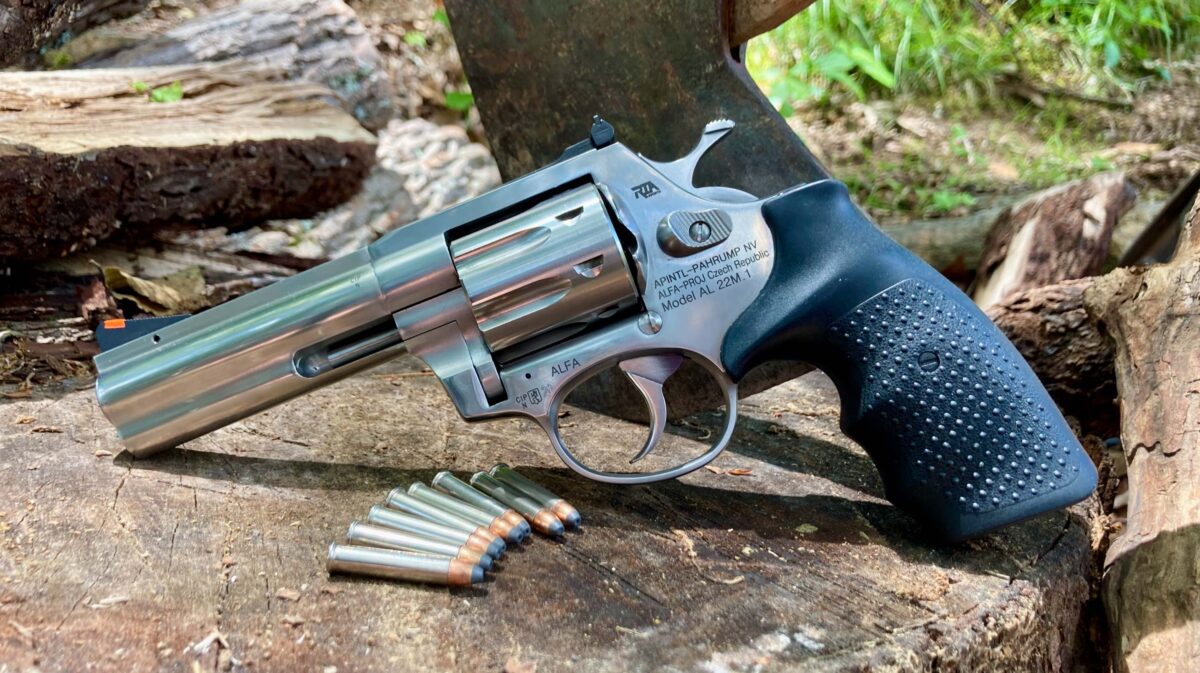
Well, shucks, this is a serious disappointment; I was interested in buying that revolver but an inaccurate firearm, though nicely finished, is a deal killer for me. Nevertheless, it’s best to know the bad news right away and avoid purchasing an expensive headache.
It doesn’t appear that the manufacturer test-fired the handgun much. If it had done so the problem likely would have been caught and rectified.
Thank you for the honest review on this gun, Justin. It’s unfortunate that both samples you tested displayed these unacceptable keyholing tendencies, especially after the way the centerfire samples they sent us performed. Hopefully, RIA and Alfa Proj take it to heart and correct this issue, it sounds like the AL22M has a lot of potential if they do.
There’s little that’s as disappointing as looking at what appears to be a well made, high end gun and finding out it can’t group shots smaller than a barn door.
The Keyholes . . . that has all the earmarks of a rifling twist that is too slow for .22 WMR bullet and the velocity in a short barrel. Unfortunately, the Alfa-Proj site does not list twist rate data, but I would wager they’re using a 1:16″ twist. That works well for the lower velocity .22 LR, but not so for the higher velocity rounds.
The .22 WMR appeared in 1959 for rifles, and a 1:14″ twist rate was used since it was also the common twist rate for .22 center fire cartridges (such as .22 Hornet) rather than the 1:16 for the .22 LR.
Most long guns chambered for .22 WMR (and even competition .22LR barrels) use a 1:14″ twist. Example: Ruger uses a 1:14 for their .22 WMR rifles. In the Ruger LCR, a 1:9 twist is used for the .22 WMR. Even in the Ruger Single Six Convertible .22/.22WMR, a 1:14″ twist is used.
The twist needs to be even faster in a short barrel to get the RPS up. Lower velocity = less revolutions per second
Wow, that’s frustrating! I’d love such a gun, but for $800, well… the keyholing would be hard to forgive.
Too bad. I would like a DA .22 Mag revolver. I sent an Email to Ruger last year asking to please make a .22 Mag version of their GP100. I love my .22 LR GP100. Who knows. Maybe they will
I like an honest review as such and I also like it when there is given the possible reasons that the review is given and possible fixes, as written. Hopefully Alfa-Proj is reading and addressing these issues. As stated it could be forcing cone geometry,
twist rate, etc. Come on Alfa-Proj, fix it!
Although the most likely cause is inadequate rifling twist, there is another apparent problem.
On image #9, there is what looks like a letter “C” stamped on the cylinder face. It looks like it is overlapping a charge hole. If that interpretation is correct, a bullet leaving that hole is going to experience an asymmetric jet of hot gas at the base of the bullet. If there is asymmetric erosion of the base, when the bullet leaves the muzzle it will get a tipping moment from the gas exiting the eroded channel. Is key-holing confined to that charge hole? Are any other charge holes also affected? Only two of the 8 are fully visible in the image.
That’s a good catch! I didn’t see that in the photos until you pointed it out. Very odd/sloppy to mark the cylinder face like that.
We’ve definitely given our feedback to RIA, and hope they’ll be able to work things out with Alfa Proj. We’ll be eager to test an improved version after it gets fixed.
Because of the obvious excellent fit and finish characteristics of this RIA revolver–qualities often lacking in today’s American-made firearms– it would be fair to give the manufacturer a chance to correct the keyholing problem and offer RevolverGuy another opportunity to test the gun. After all, U.S. gun companies regularly have similar product glitches, especially with new designs, and usually fix them.
Like having a tough boss, the beauty of honest and informed feedback is it gives the recipient an opportunity for improvement.
Great to see you back on RG Justin. I have been listening to the old ATP podcasts you updated and was thinking it would be great to have more of your articles here. I appreciate the honest review as well. I had considered this as I have the Ruger SP101 in .22LR and love it but wish they had a 22WMR version as well. I can also attest to the confidence many of us have in your reviews. I bought a Kimber K6 based on all the great information here about it and absolutely love it. It replaced an SP101 2″ and a 442 as my carry revolver when I’m not packing my 365xl.
Sir,
Those are two of the three I carry as well! The other being my Ruger LCRx. I’m glad someone else made the same choices.
Cheers
As an “ultimate wilderness survival handgun,” my first pick would be a Single-Six convertible. But…
If you’re on a hunt for a DA 22WMR, have you given a thought to the Taurus Tracker 992? Specs wise it compares to the gun you reviewed. The SA pull on mine isn’t as good, but I have to admit that I’ve never had the sideplate off for a detail cleaning, much less a “fluff and buff.”
It’s also a convertible, and I will use the 22LR cylinder for economical practice as a stand-in for my K-frame Smiths since it fits the gear.
Despite popular opinion, I find that all my convertibles (992, Single-Six, and a Blackhawk 45 colt/45ACP) shoot equally well with either cylinder. Which is certainly better than I shoot. (I can’t pretend to be a master shot with any firearm, but after an afternoon of plinking with friends, I’m not the one buying beer either.)
It should motivate the varmints to go find another chicken coop.
Thanks Scott, I appreciate your thoughts on this subject! I’m an unabashed fan of the Single Six, myself. We’ll have to try and get our hands on a Taurus Tracker 992 to evaluate. We’re working with two other guns from Taurus, right now.
I was curious, I’ve seen a few references to the RIA m206. Yes it is a very inexpensive revolver, and definitely needs some deburring and polishing out of the box. Besides possible fit and finish being worse than other brands, does it have any serious flaws? Just asking out of curiosity, I probably don’t know as much about them as most of the people here who have done research on design or had plenty of trigger time with one.
Ian, I’ve had the chance to handle those guns, but have not shot them. I can’t tell you how they perform, but maybe one of our readers can comment.
Hi Mike,
Thank you for letting me know, I’m tempted to pick one up for less than $250 and actually check it out and test it if nobody here has yet. I know their 1911’s are supposedly pretty good for the money, and a 6 shot Detective Special knockoff definitely has my attention (I just wish it was made by a different company, maybe one with a pony for a logo!) That’s a niche that needs more attention in my opinion, and the newer “Cobra” series is wrong to me for a few reasons.
Owning a small tig welding and machinist/fabrication shop I should be able to measure everything and see if there is any premature wear over a certain number of rounds or find any glaring problems with the design itself. It would be great if someone has, but if not it would be a fun project! If nobody here comments I’ll do it and let you know what I find.
-Ian
Will be interested to hear what you discover, Ian!
Hi Mike,
Well I did it! I bought the m206 about a week after we messaged about this and definitely learned a lot about it over those months. Plenty of good, some hassle of needing to basically finish some of the parts inside the gun because they just didn’t finish the gun at the factory, and one mechanical design that I’m just not really thrilled about. In the plus side it did teach me a lot about the gun mechanically which is always a good thing! With some polishing and a lot of love, it has a very nice trigger, it’s accurate and with hundreds of rounds downrange not a single hiccup. Mine especially likes 158gr SWC over 4.2gr of universal. If you want to know anything in particular or hear some detail feel free to shoot me an email, I’m always up for talking about revolvers!
Ian, thanks for the report! Sounds like you really went through that thing, and got some good results from your work!
Justin, a High Standard Sentinel in .22 Magnum is likely just the revolver you’re looking for. It’s a nine shot and some even came with extra .22 lr cylinders. High Standard made the most accurate and well made .22 Target pistols in the 1950s and 1960s and their revolvers are often overlooked because they’re not Colts or S&Ws. Mike will confirm that the High Standard revolvers are excellent firearms. The frames are aluminum alloy so they’re also light weight to carry. They’re available via the used gun market on auction sites.
I just finished reading both of your reports on the AL Series revolvers. I noticed that there was no mention of, or any photographic evidence suggesting that these revolvers have anything that serves as, a front cylinder latch. I believe that such a latch is a necessary feature of any swing-out cylinder revolver that rotates counter-clockwise, such as a S&W, Ruger, Taurus, etc.
If you look at a typical S&W revolver, for example, and compare it to a typical Colt or similar revolver, and watch the cylinder rotate while you pull the trigger or draw back the hammer, you will see that the CCW-rotation cylinder is pushed AWAY from the frame by the hand during operation. If you then do the same thing with a Colt or any CW-rotation cylinder revolver, you will see that the cylinder is pushed TOWARDS the frame by the hand during operation. So the CCW revolver tends to push the cylinder open while the CW revolver pushes the cylinder into the frame. The CW-rotation revolver therefore doesn’t NEED a forward latch.
The forward latch on a typical S&W, such as on my old Model 10, is operated by a long rod that is pushed forward by the cylinder latch when opening it, and passes through the center of the ejector rod to press a pin out of engagement with the end of the ejector rod. A new Taurus has a spring-loaded latch built into the crane that the shooter has to “overpower” when pressing the cylinder open. There are several other varieties of similar crane-mounted latches on other CCW revolvers.
With the AL-Series revolvers, all CCW rotation but with no latch, perhaps what i happening is that, as you fire the revolver in double action, maybe the hand is pushing the cylinder away from the frame just enough to push the chamber out of alignment so that the bullet shaves on the forcing cone. With a similar amount of play in both the .357 revolver and the .22, the same degree of movement may have a greater influence on the .22.
Be interesting to shoot the .22 in SA mode and see if the keyholing bullets are still a problem.
Tom, at the base of the yoke, there’s a stud that fits into a recess in the frame. When the cylinder is closed, the stud goes into the recess and bears on the frame. This is the means by which the front of the cylinder is locked up on the AL-22M. It’s not unsupported at the front, it just doesn’t lock up on the extractor rod, as with S&W revolvers.
I purchased the R.I.A. AL.22 Magnum Revolver several months ago and haven’t took the time to fire it. I registered it for warranty the day i purchased it.
Can i assume the company would notify me of any recall on the revolver ?
Does the .22 LR version have the same issues ? I have considered purchasing one of them.
Jon, we haven’t heard of any recalls on these guns. I’d suggest contacting Armscor customer service if you encounter any issues with yours when you shoot it. Hopefully it will run properly for you! Thanks for reading.
I bought a 6 inch 22 Magnum in stainless steel for the specific reason to shoot guinea fowl here in South Africa. I wanted golf ball size accuracy at about 32 yards (38 steps).Went through different types of ammo. Eventually Winchester Dynapoint 45gr gave the required accuracy. I could get 5 shots in 1.37 inch (35mm) on 38 steps from range rest over sandbags. Also had problems with CCI Maximags and it keyholed. Tough to say why its so picky, but now that I have the accuracy I want I am just going to stick with the 45gr Dynapoints.However one needs to practice a bit to get to that level of accuracy, so it took awhile, especially in the way you grip the gun and the trigger finger. Best way is to find the correct hold and trigger position is to dryfire it double action and see where it takes you on the hold and trigger finger position and then duplicate it on the single action shots. Also the target definition needs to be specific, so I used a 75% scale of a guinea fowl with a white dot as big as a tennis bal on the vital area and in the white dot I put a small diamond shape black spot to aim at. So now my project is ready to take into the veld